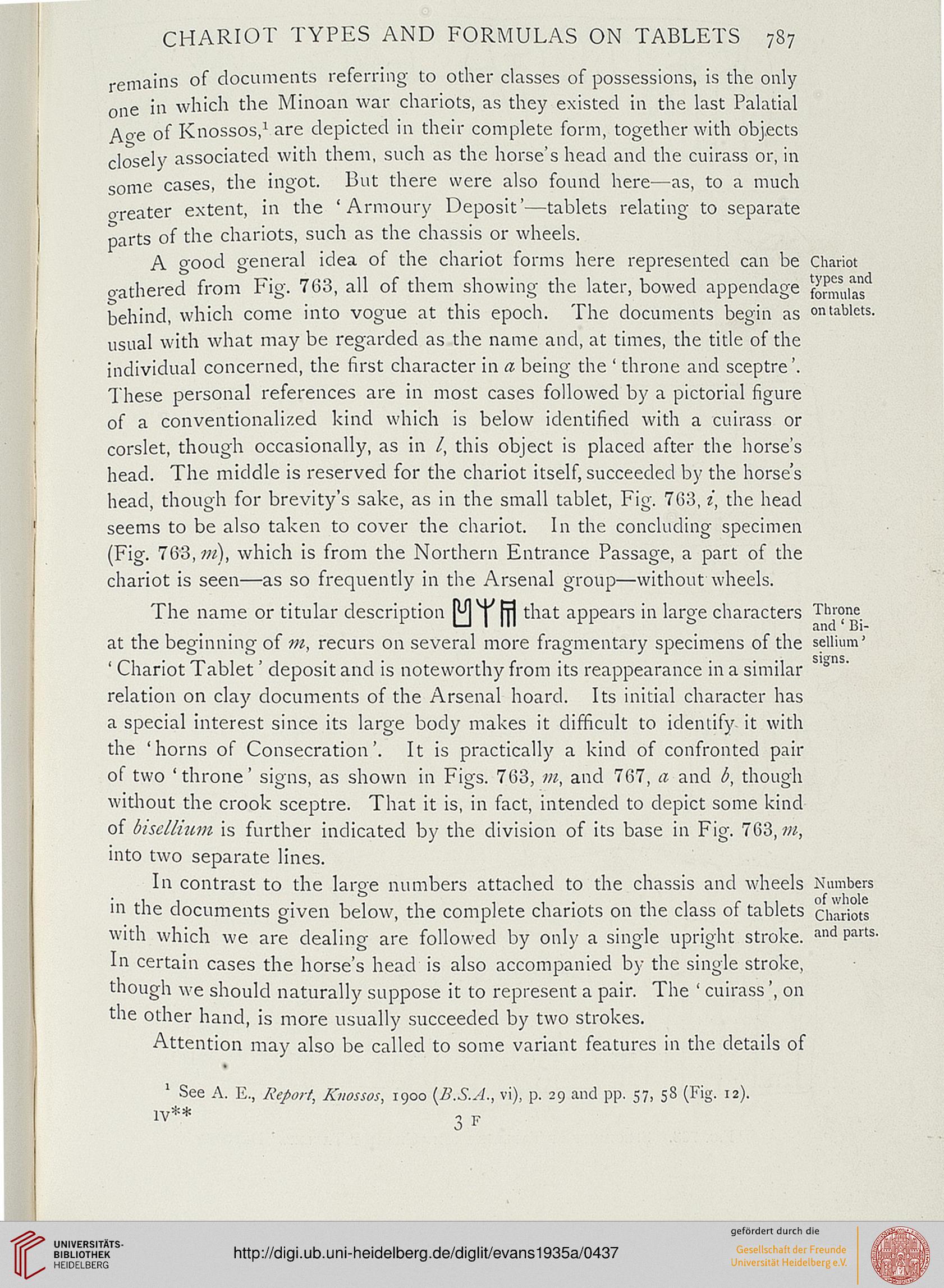CHARIOT TYPES AND FORMULAS ON TABLETS 787
remains of documents referring to other classes of possessions, is the only
one in which the Minoan war chariots, as they existed in the last Palatial
Ao-e of Knossos,1 are depicted in their complete form, together with objects
closely associated with them, such as the horse's head and the cuirass or, in
some cases, the ingot. But there were also found here—as, to a much
oreater extent, in the 'Armoury Deposit'—tablets relating to separate
parts of the chariots, such as the chassis or wheels.
A food general idea of the chariot forms here represented can be Chariot
rathered from Fig. 763, all of them showing the later, bowed appendage formulas'"
behind, which come into vogue at this epoch. The documents begin as ontablets.
usual with what may be regarded as the name and, at times, the title of the
individual concerned, the first character in a being the ' throne and sceptre'.
These personal references are in most cases followed by a pictorial figure
of a conventionalized kind which is below identified with a cuirass or
corslet, though occasionally, as in /, this object is placed after the horse's
head. The middle is reserved for the chariot itself, succeeded by the horse's
head, though for brevity's sake, as in the small tablet, Fig. 763, i, the head
seems to be also taken to cover the chariot. In the concluding specimen
(Fig. 763, m), which is from the Northern Entrance Passage, a part of the
chariot is seen—as so frequently in the Arsenal group—without wheels.
The name or titular description £j ) fj] that appears in large characters Throne
at the beginning of m, recurs on several more fragmentary specimens of the selliura'
' Chariot Tablet' deposit and is noteworthy from its reappearance in a similar
relation on clay documents of the Arsenal hoard. Its initial character has
a special interest since its large body makes it difficult to identify it with
the 'horns of Consecration'. It is practically a kind of confronted pair
of two 'throne' signs, as shown in Figs. 763, m, and 767, a and b, though
without the crook sceptre. That it is, in fact, intended to depict some kind
of bisellium is further indicated by the division of its base in Fig. 763, m,
into two separate lines.
In contrast to the large numbers attached to the chassis and wheels Numbers
in the documents given below, the complete chariots on the class of tablets chariots
with which we are dealing are followed by only a single upright stroke. a»dParts-
In certain cases the horse's head is also accompanied by the single stroke,
though we should naturally suppose it to represent a pair. The ' cuirass', on
the other hand, is more usually succeeded by two strokes.
Attention may also be called to some variant features in the details of
See A. E., Report, Knossos, 1900 (B.S.A., vi), p. 29 and pp. 57, 58 (Fig. 12).
remains of documents referring to other classes of possessions, is the only
one in which the Minoan war chariots, as they existed in the last Palatial
Ao-e of Knossos,1 are depicted in their complete form, together with objects
closely associated with them, such as the horse's head and the cuirass or, in
some cases, the ingot. But there were also found here—as, to a much
oreater extent, in the 'Armoury Deposit'—tablets relating to separate
parts of the chariots, such as the chassis or wheels.
A food general idea of the chariot forms here represented can be Chariot
rathered from Fig. 763, all of them showing the later, bowed appendage formulas'"
behind, which come into vogue at this epoch. The documents begin as ontablets.
usual with what may be regarded as the name and, at times, the title of the
individual concerned, the first character in a being the ' throne and sceptre'.
These personal references are in most cases followed by a pictorial figure
of a conventionalized kind which is below identified with a cuirass or
corslet, though occasionally, as in /, this object is placed after the horse's
head. The middle is reserved for the chariot itself, succeeded by the horse's
head, though for brevity's sake, as in the small tablet, Fig. 763, i, the head
seems to be also taken to cover the chariot. In the concluding specimen
(Fig. 763, m), which is from the Northern Entrance Passage, a part of the
chariot is seen—as so frequently in the Arsenal group—without wheels.
The name or titular description £j ) fj] that appears in large characters Throne
at the beginning of m, recurs on several more fragmentary specimens of the selliura'
' Chariot Tablet' deposit and is noteworthy from its reappearance in a similar
relation on clay documents of the Arsenal hoard. Its initial character has
a special interest since its large body makes it difficult to identify it with
the 'horns of Consecration'. It is practically a kind of confronted pair
of two 'throne' signs, as shown in Figs. 763, m, and 767, a and b, though
without the crook sceptre. That it is, in fact, intended to depict some kind
of bisellium is further indicated by the division of its base in Fig. 763, m,
into two separate lines.
In contrast to the large numbers attached to the chassis and wheels Numbers
in the documents given below, the complete chariots on the class of tablets chariots
with which we are dealing are followed by only a single upright stroke. a»dParts-
In certain cases the horse's head is also accompanied by the single stroke,
though we should naturally suppose it to represent a pair. The ' cuirass', on
the other hand, is more usually succeeded by two strokes.
Attention may also be called to some variant features in the details of
See A. E., Report, Knossos, 1900 (B.S.A., vi), p. 29 and pp. 57, 58 (Fig. 12).




